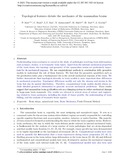Mostrar el registro sencillo del ítem
Topological features dictate the mechanics of the mammalian brains
| dc.creator | Sáez, Pablo | es_ES |
| dc.creator | Duñó, C. | es_ES |
| dc.creator | Sun, L.Y. | es_ES |
| dc.creator | Antonovaite, N. | es_ES |
| dc.creator | Malvè, Mauro | es_ES |
| dc.creator | Tost, D. | es_ES |
| dc.creator | Goriely, A. | es_ES |
| dc.date.accessioned | 2020-07-07T17:21:16Z | |
| dc.date.available | 2022-12-01T00:00:14Z | |
| dc.date.issued | 2020 | |
| dc.identifier.issn | 0020-7403 | |
| dc.identifier.uri | https://hdl.handle.net/2454/37312 | |
| dc.description.abstract | Understanding brain mechanics is crucial in the study of pathologies involving brain deformations such as tumor, strokes, or in traumatic brain injury. Apart from the intrinsic mechanical properties of the brain tissue, the topology and geometry of the mammalian brains are particularly important for its mechanical response. We use computational methods in combination with geometric models to understand the role of these features. We find that the geometric quantifiers such as the gyrification index play a fundamental role in the overall mechanical response of the brain. We further demonstrate that topological diversity in brain models is more important than differences in mechanical properties: Topological differences modify not only the stresses and strains in the brain but also its spatial distribution. Therefore, computational brain models should always include detailed geometric information to generate accurate mechanical predictions. These results suggest that mammalian brain gyrification acts as a damping system to reduce mechanical damage in large-mass brain mammals. Our results are relevant in several areas of science and engineering related to brain mechanics, including the study of tumor growth, the understanding of brain folding, and the analysis of traumatic brain injuries. | en |
| dc.description.sponsorship | P.S has been supported by the Generalitat de Catalunya under grants 2017-SGR-1278. N.A acknowledge funding from the European Research Council under the European Union’s Seventh Framework Programme (FP/2007–2013)/ERC grant agreement no. [615170]. This work was supported by a Engineering and Physical Sciences Research Council grant to Alain Goriely (EP/R020205/1). | en |
| dc.format.extent | 17 p. | |
| dc.format.mimetype | application/pdf | en |
| dc.language.iso | eng | en |
| dc.publisher | Elsevier | |
| dc.relation.ispartof | International Journal of Mechanical Sciences 187 (2020) 105914 | en |
| dc.rights | © 2019 Elsevier Ltd. This manuscript version is made available under the CC-BY-NC-ND 4.0. | en |
| dc.rights.uri | http://creativecommons.org/licenses/by-nc-nd/4.0/ | |
| dc.subject | Brain shape | en |
| dc.subject | Animal-scale laws | en |
| dc.subject | Brain mechanics | en |
| dc.subject | Finite element method | en |
| dc.title | Topological features dictate the mechanics of the mammalian brains | en |
| dc.type | Artículo / Artikulua | es |
| dc.type | info:eu-repo/semantics/article | en |
| dc.contributor.department | Ingeniería | es_ES |
| dc.contributor.department | Ingeniaritza | eu |
| dc.rights.accessRights | Acceso abierto / Sarbide irekia | es |
| dc.rights.accessRights | info:eu-repo/semantics/openAccess | en |
| dc.embargo.terms | 2022-12-01 | |
| dc.identifier.doi | 10.1016/j.ijmecsci.2020.105914 | |
| dc.relation.projectID | info:eu-repo/grantAgreement/European Commission/FP7/615170 | en |
| dc.relation.publisherversion | https://doi.org/10.1016/j.ijmecsci.2020.105914 | |
| dc.type.version | Versión aceptada / Onetsi den bertsioa | es |
| dc.type.version | info:eu-repo/semantics/acceptedVersion | en |



